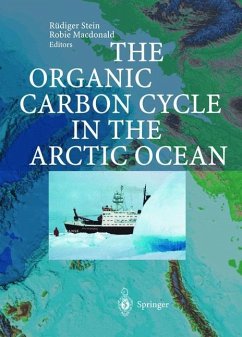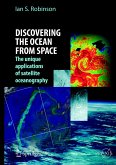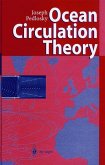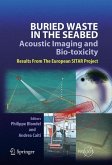Rüdiger Stein / Robie Macdonald (eds.)
The Organic Carbon Cycle in the Arctic Ocean
Herausgegeben:Stein, Rüdiger; Macdonald, Robie W.
Rüdiger Stein / Robie Macdonald (eds.)
The Organic Carbon Cycle in the Arctic Ocean
Herausgegeben:Stein, Rüdiger; Macdonald, Robie W.
- Gebundenes Buch
- Merkliste
- Auf die Merkliste
- Bewerten Bewerten
- Teilen
- Produkt teilen
- Produkterinnerung
- Produkterinnerung
To understand the global oceanic carbon budget and related climate change, exact measurements of organic carbon flux in all oceans environments, especially the continental margins, are crucial. In fact, data have been available for some time on organic carbon sources, pathways, and burial for most of the world's oceans, with the notable exception of the Arctic. With this book, the editors remedy this gap in knowledge, presenting an overview of organic-carbon sources, pathways, and burial of the circum-Arctic continental margin and deep-sea areas. Data from each Arctic shelf and basin are…mehr
Andere Kunden interessierten sich auch für
![Sea-Ice and Iceberg Sedimentation in the Ocean Sea-Ice and Iceberg Sedimentation in the Ocean]() Alexander P. LisitzinSea-Ice and Iceberg Sedimentation in the Ocean156,99 €
Alexander P. LisitzinSea-Ice and Iceberg Sedimentation in the Ocean156,99 €![Waves in the Ocean and Atmosphere Waves in the Ocean and Atmosphere]() Joseph PedloskyWaves in the Ocean and Atmosphere83,99 €
Joseph PedloskyWaves in the Ocean and Atmosphere83,99 €![Breaking Ocean Waves Breaking Ocean Waves]() Eugene A. SharkovBreaking Ocean Waves77,99 €
Eugene A. SharkovBreaking Ocean Waves77,99 €![Discovering the Ocean from Space Discovering the Ocean from Space]() Ian S. RobinsonDiscovering the Ocean from Space148,99 €
Ian S. RobinsonDiscovering the Ocean from Space148,99 €![Ocean Circulation Theory Ocean Circulation Theory]() Joseph PedloskyOcean Circulation Theory225,99 €
Joseph PedloskyOcean Circulation Theory225,99 €![Buried Waste in the Seabed ¿ Acoustic Imaging and Bio-toxicity Buried Waste in the Seabed ¿ Acoustic Imaging and Bio-toxicity]() Philippe BlondelBuried Waste in the Seabed ¿ Acoustic Imaging and Bio-toxicity116,99 €
Philippe BlondelBuried Waste in the Seabed ¿ Acoustic Imaging and Bio-toxicity116,99 €![Marine Surface Films Marine Surface Films]() GadeMarine Surface Films116,99 €
GadeMarine Surface Films116,99 €-
-
-
To understand the global oceanic carbon budget and related climate change, exact measurements of organic carbon flux in all oceans environments, especially the continental margins, are crucial. In fact, data have been available for some time on organic carbon sources, pathways, and burial for most of the world's oceans, with the notable exception of the Arctic. With this book, the editors remedy this gap in knowledge, presenting an overview of organic-carbon sources, pathways, and burial of the circum-Arctic continental margin and deep-sea areas. Data from each Arctic shelf and basin are collated, presented in common and parallel formats, and related to the global carbon cycle. The book is suitable for lecturers, graduate students as well as scientists interested in the organic-carbon-cycle and Arctic Ocean (paleo-)environment.
The flux,preservation,and accumulation of organic carbon in marine systems are controlled by various mechanisms including primary p- duction of the surface water,supply of terrigenous organic matter from the surrounding continents, biogeochemical processes in the water column and at the seafloor, and sedimentation rate. For the world s oceans,phytoplankton productivity is by far the largest organic carbon 9 source,estimated to be about 30 to 50 Gt (10 tonnes) per year (Berger et al. 1989; Hedges and Keil 1995). By comparison, rivers contribute 1 about 0. 15 to 0. 23 Gt y of particulate organic carbon (Ittekkot 1988; 1 Hedges et al. 1997). On average,only about 0. 1 0. 2 Gt y of the organic carbon supplied to the world s oceans has been buried in Holocene sediments, with perhaps 85 90% of that being deposited in deltaic, shelf and upper slope sediments (Romankevich 1984; Berner 1989; Hedges and Keil 1995). To refine the global ocean carbon budget in general and,specifically,to quantify organic carbon burial because it is so important for climatic change, we need detailed measurements of the organic carbon flux in all ocean environments, especially for c- tinental margins (e. g. ,Liu et al. ,2000). With the notable exception of the Arctic Ocean, data have been available for some time on organic carbon sources, pathways and burial in a variety of ocean envir- ments.
The flux,preservation,and accumulation of organic carbon in marine systems are controlled by various mechanisms including primary p- duction of the surface water,supply of terrigenous organic matter from the surrounding continents, biogeochemical processes in the water column and at the seafloor, and sedimentation rate. For the world s oceans,phytoplankton productivity is by far the largest organic carbon 9 source,estimated to be about 30 to 50 Gt (10 tonnes) per year (Berger et al. 1989; Hedges and Keil 1995). By comparison, rivers contribute 1 about 0. 15 to 0. 23 Gt y of particulate organic carbon (Ittekkot 1988; 1 Hedges et al. 1997). On average,only about 0. 1 0. 2 Gt y of the organic carbon supplied to the world s oceans has been buried in Holocene sediments, with perhaps 85 90% of that being deposited in deltaic, shelf and upper slope sediments (Romankevich 1984; Berner 1989; Hedges and Keil 1995). To refine the global ocean carbon budget in general and,specifically,to quantify organic carbon burial because it is so important for climatic change, we need detailed measurements of the organic carbon flux in all ocean environments, especially for c- tinental margins (e. g. ,Liu et al. ,2000). With the notable exception of the Arctic Ocean, data have been available for some time on organic carbon sources, pathways and burial in a variety of ocean envir- ments.
Produktdetails
- Produktdetails
- Verlag: Springer / Springer Berlin Heidelberg / Springer, Berlin
- Artikelnr. des Verlages: 978-3-540-01153-8
- Repr. d. Ausg. v. 2003
- Seitenzahl: 384
- Erscheinungstermin: 22. September 2003
- Englisch
- Abmessung: 286mm x 215mm x 29mm
- Gewicht: 1158g
- ISBN-13: 9783540011538
- ISBN-10: 3540011536
- Artikelnr.: 12146764
- Verlag: Springer / Springer Berlin Heidelberg / Springer, Berlin
- Artikelnr. des Verlages: 978-3-540-01153-8
- Repr. d. Ausg. v. 2003
- Seitenzahl: 384
- Erscheinungstermin: 22. September 2003
- Englisch
- Abmessung: 286mm x 215mm x 29mm
- Gewicht: 1158g
- ISBN-13: 9783540011538
- ISBN-10: 3540011536
- Artikelnr.: 12146764
Rüdiger Stein, Alfred Wegener Institute for Polar and Marine Research, Bremerhaven, Germany / Robie Macdonald, Institute of Ocean Sciences, Sidney, BC, Canada
1 The Arctic Ocean: Boundary Conditions and Background Information.- 1.1 Physiography and Bathymetry of the Arctic Ocean.- 1.1.1 Introduction.- 1.1.2 Definition of the Arctic Ocean and its Constituent Seas.- 1.1.3 Bathymetry and Physiography.- 1.1.4 Volumes, Areas and Mean Depths of the Arctic Ocean and its Constituent Seas.- 1.2 The Arctic Ocean: Modern Status and Recent Climate Change.- 1.2.1 Modern hydrography and Sea-ice Cover of the Arctic Ocean.- 1.2.2 The Arctic Ocean and Global Change.- 1.2.2.1 The distant past.- 1.2.2.2 Recent change and the Arctic Oscillation.- 1.2.2.3 The Future.- 1.3 The Tectonic Evolution of the Arctic Ocean: Overview and Perspectives.- 1.4 Geochemical Proxies Used for Organic Carbon Source Identification in Arctic Ocean Sediments.- 1.4.1 Introduction.- 1.4.2 Organic geochemical bulk parameters.- 1.4.3 Maceral composition.- 1.4.4 Biomarker composition.- 1.4.5 The application of redox markers to organic carbon sediment geochemistry.- 2 Modern Terrigenous Organic Carbon Input to the Arctic Ocean.- 2.1 General Introduction.- 2.2 River Input.- 2.2.1 Introduction.- 2.2.2 River water and suspended matter.- 2.2.3 Fluxes of organic carbon.- 2.3 Organic Carbon Input to the Artic Seas Through Coastal Erosion.- 2.3.1 Introduction.- 2.3.2 Methodology.- 2.3.3 Coastal organic carbon input.- 2.4 The Role of Arctic Sea Ice in Transporting and Cycling Terrestrial Organic Matter.- 2.4.1 Introduction.- 2.4.2 Methods.- 2.4.3 Sea ice transport in the Arctic Ocean and entrainment of particulate matter.- 2.4.4 Dissolved organic carbon in sea ice.- 2.4.5 Particulate organic carbon in sea ice.- 2.4.6 Conclusions.- 2.5 Aeolian Input.- 2.6 Summary and Concluding Remarks.- 3 Primary and Secondary Production in the Arctic Seas.- 3.1 Introduction.- 3.2 Major Algal Groups and Their Distribution.- 3.2.1 Distribution of species.- 3.2.2 Nutritional and chemical properties.- 3.3 Limitation and Control of Primary Production.- 3.3.1 Light.- 3.3.2 Nutrients.- 3.4 Primary Production and Growth Rate.- 3.4.1 New vs. regenerative primary production.- 3.4.2 Chla: C ratio, light saturation index, photoacclimation.- 3.4.3 Growth rate.- 3.4.4 Growth strategies.- 3.5 Seasonality.- 3.5.1 Pre-bloom, winter and survial.- 3.5.2 Spring blooms, vertical mixing and ice-edge blooms.- 3.5.3 The post bloom.- 3.6 Distribution of Primary Production.- 3.6.1 The deep Arctic Ocean Basin.- 3.6.2 Polynyas.- 3.6.3 Arctic Shelf Seas.- 3.6.4 The Atlantic sector: The Nordic Seas, Baffin Bay, Hudson Bay and Labrador Sea.- 3.6.5 Bering Shelf.- 3.6.6 Oceanic Bering Sea.- 3.6.7 Sea of Okhotsk.- 3.7 Mesozooplankton.- 3.7.1 Mesozooplankton biomass.- 3.7.2 Grazing and mesozooplankton production.- 3.7.3 Match-mismatch.- 3.8 Primary Production - Impact of Climate Change.- 3.9 Summary and Concluding Remarks.- 4 The Role of Dissolved Organic Matter for the Organic Carbon Cycle in the Arctic Ocean.- 4.1 Introduction.- 4.2 Riverine DOM on Arctic Shelves and Beyond.- 4.2.1 Estuarine Mixing.- 4.2.2 Chemical characteristics and origin of DOM on the Eurasian shelf.- 4.2.3 The role of bacteria and photochemical processes on the Eurasian shelf.- 4.2.4 The role of sea ice formation on DOM on the Eurasian shelf.- 4.2.5 The distribution of terrestrial DOM in the central Arctic Ocean and the GIN Sea.- 4.3 Distribution, Chemical Composition, and Fluxes of Marine DOM in the Central Arctic Ocean.- 4.3.1 Primary production and bacterial utilization of DOM.- 4.3.2 DOM distribution and chemical composition.- 4.3.3 DOC exchanges between the Arctic Ocean and adjacent Ocean basins.- 4.3.4 Vertical export of DOC in the Arctic Ocean.- 4.4 Summary and Concluding Remarks.- 5 Particulate Organic Carbon Flux to the Arctic Ocean Sea Floor.- 5.1 Introduction.- 5.2 What do we Know About Vertical Carbon Flux from the Arctic Ocean.- 5.3 Case Studies.- 5.3.1 North Water Polynya (B. Hargrave).- 5.3.2 North East Water Polynya (E. Bauerfeind).- 5.3.3 Greenland Sea (R. Peinert, T. Noji).- 5.3.4 Central Barents Sea and Northern Spitsbergen.- 5.3.5 Eastern Barents Sea and Kara Sea (V. Shevchenko).- 5.3.6 Laptev Sea and Lomonosov Ridge (E.-M. Nöthig, V. Shevchenko).- 5.3.7 Northern Bering Sea (H. Sasaki, M. Fukuchi).- 5.3.8 Canadian Ice Island (B. Hargrave).- 5.3.9 Canadian Archipelago: Barrow Strait (M. Fortier).- 5.4 Regional Variability in POC Export Flux in the Arctic Ocean Determined Using 234Th as a Tracer.- 5.4.1 Introduction and Background.- 5.4.2 Uncertainties in 234Th-derived POC Export Fluxes.- 5.4.3 Regional Variability in Arctic POC Export Fluxes.- 5.4.4 Conclusions.- 5.5 Particulate Organic Carbon Flux to the Seafloor of the Arctic Ocean: Quantity, Seasonality and Processes.- 5.5.1 Seasonal and Annual Estimates of Vertical Carbon Export.- 5.5.2 Ice, Light, Stratification, and Vertical Carbon Export.- 5.5.3 River Run-off, Resuspension, and Vertical Carbon Export.- 5.5.4 High Retention of Vertical Carbon Export in the Twilight Zone of the Arctic Ocean.- 5.5.5 Global Warming and Vertical Carbon Export.- 5.6 Summary and Concluding Remarks.- 6 The Benthos of Arctic Seas and its Role for the Organic Carbon Cycle at the Seafloor.- 6.1 Introduction.- 6.2 Origin and Evolution of Arctic Habitats and Species.- 6.3 Food Supply of the Arctic Benthos: Sources and Pathways.- 6.4 Benthic Communities of the Arctic Seas.- 6.4.1 Arctic Shelves and Margins.- 6.4.2 Central Arctic.- 6.5 Organic Carbon Utilization by the Arctic Benthos.- 6.5.1 Arctic Continental Shelves.- 6.5.2 Central Arctic Ocean.- 6.6 Summary and Concluding Remarks.- 7 Organic Carbon in Arctic Ocean Sediments: Sources, Variability, Burial, and Paleoenvironmental Significance.- 7.1 Organic Carbon in Arctic Ocean Sediments: A General Introduction.- 7.1.1 Pre-Quaternary (Jurassic-Cretaceous) Organic Carbon Records.- 7.1.2 Modern and Late Quaternary Organic Carbon Records.- 7.2 The Beaufort Sea: Distribution, Sources, Fluxes, and Burial Rates of Organic Carbon.- 7.2.1 Introduction.- 7.2.2 Data Base.- 7.2.3 Distribution and Sources of Organic Carbon in Surface Sediments.- 7.2.4 The Effect of Sea-level Rise During the Holocene.- 7.2.5 Burial Rates of Organic Carbon and Budget.- 7.2.6 Summary and Concluding Remarks.- 7.3 The Continental Margin of the North Bering-Chukchi Sea: Distribution, Sources, Fluxes, and Burial Rates of Organic Carbon.- 7.3.1 Introduction.- 7.3.2 Data Base, Material and Methods.- 7.3.3 Distribution and Sources of Organic Carbon in Surface Sediments.- 7.3.4 Fluxes, Accumulation, Burial Rates, and Remineralization of OC, and Benthic Oxygen Uptake Rates.- 7.3.5 Summary and Concluding Remarks.- 7.4 The East Siberian Sea: Distribution, Sources, and Burial of Organic Carbon.- 7.4.1 Introduction.- 7.4.2 Data base, Material and Methods.- 7.4.3 Distribution and Sources of Organic Carbon in Surface Sediments.- 7.4.4 Burial Rates of Organic Carbon.- 7.4.5 Summary and Concluding Remarks.- 7.5 The Laptev Sea: Distribution, Sources,Variability and Burial of Organic Carbon.- 7.5.1 Introduction.- 7.5.2 Data base, Material and Methods.- 7.5.3 Distribution and Sources of Organic Carbon in Surface Sediments.- 7.5.4 Late Quaternary Organic Carbon Records and Paleoenvironment.- 7.5.5 Accumulation Rates and Budget of Total Sediment and Organic Carbon.- 7.5.6 Summary and Concluding Remarks.- 7.6 The Kara Sea: Distribution, Sources,Variability and Burial of Organic Carbon.- 7.6.1 Introduction.- 7.6.2 Data base, Material and Methods.- 7.6.3 Distribution and Sources of Organic Carbon in Surface Sediments.- 7.6.4 Late Quaternary Organic Carbon Records and Paleoenvironment.- 7.6.5 Budget of Total Sediment and Organic Carbon.- 7.6.6 Summary and Concluding Remarks.- 7.7 The Barents Sea: Distribution, Sources,Variability and Burial of Organic Carbon.- 7.7.1 Introduction.- 7.7.2 Data base, Material and Methods.- 7.7.3 Distribution and Sources of Organic Carbon in Surface Sediments.- 7.7.4 Late Quaternary Organic Carbon Records and Paleoenvironment.- 7.7.5 Burial Rates and Organic Carbon Budget.- 7.7.6 Summary and Concluding Remarks.- 7.8 Northern Fram Strait und Yermak Plateau: Distribution,Variability and Burial of Organic Carbon and Paleoenvironmental Implications.- 7.8.1 Introduction.- 7.8.2 Data base, Material and Methods.- 7.8.3 Distribution and Sources of Organic Carbon in Surface Sediments.- 7.8.4 Late Quaternary Organic Carbon Records and Paleoenvironment.- 7.8.5 Accumulation Rates and Organic Carbon Budget.- 7.8.6 Summary and Concluding Remarks.- 7.9 The Central Arctic Ocean: Distribution, Sources, Variability and Burial of Organic Carbon.- 7.9.1 Introduction.- 7.9.2 Data base, Material and Methods.- 7.9.3 Distribution and Sources of Organic Carbon in Surface Sediments.- 7.9.4 Late Quaternary Organic Carbon Records and Paleoenvironment.- 7.9.5 Accumulation Rates and Budget of Total Sediment and Organic Carbon.- 7.9.6 Summary and Concluding Remarks.- 8 Organic Carbon Budget: Arctic Ocean vs. Global Ocean.- 8.1 Introduction.- 8.2 Global Organic Carbon Fluxes: Sources and Sinks.- 8.3 Arctic Ocean Organic Carbon Fluxes: Sources and Sinks.- 8.4 Summary and Concluding Remarks.- 9 References.
1 The Arctic Ocean: Boundary Conditions and Background Information.- 1.1 Physiography and Bathymetry of the Arctic Ocean.- 1.1.1 Introduction.- 1.1.2 Definition of the Arctic Ocean and its Constituent Seas.- 1.1.3 Bathymetry and Physiography.- 1.1.4 Volumes, Areas and Mean Depths of the Arctic Ocean and its Constituent Seas.- 1.2 The Arctic Ocean: Modern Status and Recent Climate Change.- 1.2.1 Modern hydrography and Sea-ice Cover of the Arctic Ocean.- 1.2.2 The Arctic Ocean and Global Change.- 1.2.2.1 The distant past.- 1.2.2.2 Recent change and the Arctic Oscillation.- 1.2.2.3 The Future.- 1.3 The Tectonic Evolution of the Arctic Ocean: Overview and Perspectives.- 1.4 Geochemical Proxies Used for Organic Carbon Source Identification in Arctic Ocean Sediments.- 1.4.1 Introduction.- 1.4.2 Organic geochemical bulk parameters.- 1.4.3 Maceral composition.- 1.4.4 Biomarker composition.- 1.4.5 The application of redox markers to organic carbon sediment geochemistry.- 2 Modern Terrigenous Organic Carbon Input to the Arctic Ocean.- 2.1 General Introduction.- 2.2 River Input.- 2.2.1 Introduction.- 2.2.2 River water and suspended matter.- 2.2.3 Fluxes of organic carbon.- 2.3 Organic Carbon Input to the Artic Seas Through Coastal Erosion.- 2.3.1 Introduction.- 2.3.2 Methodology.- 2.3.3 Coastal organic carbon input.- 2.4 The Role of Arctic Sea Ice in Transporting and Cycling Terrestrial Organic Matter.- 2.4.1 Introduction.- 2.4.2 Methods.- 2.4.3 Sea ice transport in the Arctic Ocean and entrainment of particulate matter.- 2.4.4 Dissolved organic carbon in sea ice.- 2.4.5 Particulate organic carbon in sea ice.- 2.4.6 Conclusions.- 2.5 Aeolian Input.- 2.6 Summary and Concluding Remarks.- 3 Primary and Secondary Production in the Arctic Seas.- 3.1 Introduction.- 3.2 Major Algal Groups and Their Distribution.- 3.2.1 Distribution of species.- 3.2.2 Nutritional and chemical properties.- 3.3 Limitation and Control of Primary Production.- 3.3.1 Light.- 3.3.2 Nutrients.- 3.4 Primary Production and Growth Rate.- 3.4.1 New vs. regenerative primary production.- 3.4.2 Chla: C ratio, light saturation index, photoacclimation.- 3.4.3 Growth rate.- 3.4.4 Growth strategies.- 3.5 Seasonality.- 3.5.1 Pre-bloom, winter and survial.- 3.5.2 Spring blooms, vertical mixing and ice-edge blooms.- 3.5.3 The post bloom.- 3.6 Distribution of Primary Production.- 3.6.1 The deep Arctic Ocean Basin.- 3.6.2 Polynyas.- 3.6.3 Arctic Shelf Seas.- 3.6.4 The Atlantic sector: The Nordic Seas, Baffin Bay, Hudson Bay and Labrador Sea.- 3.6.5 Bering Shelf.- 3.6.6 Oceanic Bering Sea.- 3.6.7 Sea of Okhotsk.- 3.7 Mesozooplankton.- 3.7.1 Mesozooplankton biomass.- 3.7.2 Grazing and mesozooplankton production.- 3.7.3 Match-mismatch.- 3.8 Primary Production - Impact of Climate Change.- 3.9 Summary and Concluding Remarks.- 4 The Role of Dissolved Organic Matter for the Organic Carbon Cycle in the Arctic Ocean.- 4.1 Introduction.- 4.2 Riverine DOM on Arctic Shelves and Beyond.- 4.2.1 Estuarine Mixing.- 4.2.2 Chemical characteristics and origin of DOM on the Eurasian shelf.- 4.2.3 The role of bacteria and photochemical processes on the Eurasian shelf.- 4.2.4 The role of sea ice formation on DOM on the Eurasian shelf.- 4.2.5 The distribution of terrestrial DOM in the central Arctic Ocean and the GIN Sea.- 4.3 Distribution, Chemical Composition, and Fluxes of Marine DOM in the Central Arctic Ocean.- 4.3.1 Primary production and bacterial utilization of DOM.- 4.3.2 DOM distribution and chemical composition.- 4.3.3 DOC exchanges between the Arctic Ocean and adjacent Ocean basins.- 4.3.4 Vertical export of DOC in the Arctic Ocean.- 4.4 Summary and Concluding Remarks.- 5 Particulate Organic Carbon Flux to the Arctic Ocean Sea Floor.- 5.1 Introduction.- 5.2 What do we Know About Vertical Carbon Flux from the Arctic Ocean.- 5.3 Case Studies.- 5.3.1 North Water Polynya (B. Hargrave).- 5.3.2 North East Water Polynya (E. Bauerfeind).- 5.3.3 Greenland Sea (R. Peinert, T. Noji).- 5.3.4 Central Barents Sea and Northern Spitsbergen.- 5.3.5 Eastern Barents Sea and Kara Sea (V. Shevchenko).- 5.3.6 Laptev Sea and Lomonosov Ridge (E.-M. Nöthig, V. Shevchenko).- 5.3.7 Northern Bering Sea (H. Sasaki, M. Fukuchi).- 5.3.8 Canadian Ice Island (B. Hargrave).- 5.3.9 Canadian Archipelago: Barrow Strait (M. Fortier).- 5.4 Regional Variability in POC Export Flux in the Arctic Ocean Determined Using 234Th as a Tracer.- 5.4.1 Introduction and Background.- 5.4.2 Uncertainties in 234Th-derived POC Export Fluxes.- 5.4.3 Regional Variability in Arctic POC Export Fluxes.- 5.4.4 Conclusions.- 5.5 Particulate Organic Carbon Flux to the Seafloor of the Arctic Ocean: Quantity, Seasonality and Processes.- 5.5.1 Seasonal and Annual Estimates of Vertical Carbon Export.- 5.5.2 Ice, Light, Stratification, and Vertical Carbon Export.- 5.5.3 River Run-off, Resuspension, and Vertical Carbon Export.- 5.5.4 High Retention of Vertical Carbon Export in the Twilight Zone of the Arctic Ocean.- 5.5.5 Global Warming and Vertical Carbon Export.- 5.6 Summary and Concluding Remarks.- 6 The Benthos of Arctic Seas and its Role for the Organic Carbon Cycle at the Seafloor.- 6.1 Introduction.- 6.2 Origin and Evolution of Arctic Habitats and Species.- 6.3 Food Supply of the Arctic Benthos: Sources and Pathways.- 6.4 Benthic Communities of the Arctic Seas.- 6.4.1 Arctic Shelves and Margins.- 6.4.2 Central Arctic.- 6.5 Organic Carbon Utilization by the Arctic Benthos.- 6.5.1 Arctic Continental Shelves.- 6.5.2 Central Arctic Ocean.- 6.6 Summary and Concluding Remarks.- 7 Organic Carbon in Arctic Ocean Sediments: Sources, Variability, Burial, and Paleoenvironmental Significance.- 7.1 Organic Carbon in Arctic Ocean Sediments: A General Introduction.- 7.1.1 Pre-Quaternary (Jurassic-Cretaceous) Organic Carbon Records.- 7.1.2 Modern and Late Quaternary Organic Carbon Records.- 7.2 The Beaufort Sea: Distribution, Sources, Fluxes, and Burial Rates of Organic Carbon.- 7.2.1 Introduction.- 7.2.2 Data Base.- 7.2.3 Distribution and Sources of Organic Carbon in Surface Sediments.- 7.2.4 The Effect of Sea-level Rise During the Holocene.- 7.2.5 Burial Rates of Organic Carbon and Budget.- 7.2.6 Summary and Concluding Remarks.- 7.3 The Continental Margin of the North Bering-Chukchi Sea: Distribution, Sources, Fluxes, and Burial Rates of Organic Carbon.- 7.3.1 Introduction.- 7.3.2 Data Base, Material and Methods.- 7.3.3 Distribution and Sources of Organic Carbon in Surface Sediments.- 7.3.4 Fluxes, Accumulation, Burial Rates, and Remineralization of OC, and Benthic Oxygen Uptake Rates.- 7.3.5 Summary and Concluding Remarks.- 7.4 The East Siberian Sea: Distribution, Sources, and Burial of Organic Carbon.- 7.4.1 Introduction.- 7.4.2 Data base, Material and Methods.- 7.4.3 Distribution and Sources of Organic Carbon in Surface Sediments.- 7.4.4 Burial Rates of Organic Carbon.- 7.4.5 Summary and Concluding Remarks.- 7.5 The Laptev Sea: Distribution, Sources,Variability and Burial of Organic Carbon.- 7.5.1 Introduction.- 7.5.2 Data base, Material and Methods.- 7.5.3 Distribution and Sources of Organic Carbon in Surface Sediments.- 7.5.4 Late Quaternary Organic Carbon Records and Paleoenvironment.- 7.5.5 Accumulation Rates and Budget of Total Sediment and Organic Carbon.- 7.5.6 Summary and Concluding Remarks.- 7.6 The Kara Sea: Distribution, Sources,Variability and Burial of Organic Carbon.- 7.6.1 Introduction.- 7.6.2 Data base, Material and Methods.- 7.6.3 Distribution and Sources of Organic Carbon in Surface Sediments.- 7.6.4 Late Quaternary Organic Carbon Records and Paleoenvironment.- 7.6.5 Budget of Total Sediment and Organic Carbon.- 7.6.6 Summary and Concluding Remarks.- 7.7 The Barents Sea: Distribution, Sources,Variability and Burial of Organic Carbon.- 7.7.1 Introduction.- 7.7.2 Data base, Material and Methods.- 7.7.3 Distribution and Sources of Organic Carbon in Surface Sediments.- 7.7.4 Late Quaternary Organic Carbon Records and Paleoenvironment.- 7.7.5 Burial Rates and Organic Carbon Budget.- 7.7.6 Summary and Concluding Remarks.- 7.8 Northern Fram Strait und Yermak Plateau: Distribution,Variability and Burial of Organic Carbon and Paleoenvironmental Implications.- 7.8.1 Introduction.- 7.8.2 Data base, Material and Methods.- 7.8.3 Distribution and Sources of Organic Carbon in Surface Sediments.- 7.8.4 Late Quaternary Organic Carbon Records and Paleoenvironment.- 7.8.5 Accumulation Rates and Organic Carbon Budget.- 7.8.6 Summary and Concluding Remarks.- 7.9 The Central Arctic Ocean: Distribution, Sources, Variability and Burial of Organic Carbon.- 7.9.1 Introduction.- 7.9.2 Data base, Material and Methods.- 7.9.3 Distribution and Sources of Organic Carbon in Surface Sediments.- 7.9.4 Late Quaternary Organic Carbon Records and Paleoenvironment.- 7.9.5 Accumulation Rates and Budget of Total Sediment and Organic Carbon.- 7.9.6 Summary and Concluding Remarks.- 8 Organic Carbon Budget: Arctic Ocean vs. Global Ocean.- 8.1 Introduction.- 8.2 Global Organic Carbon Fluxes: Sources and Sinks.- 8.3 Arctic Ocean Organic Carbon Fluxes: Sources and Sinks.- 8.4 Summary and Concluding Remarks.- 9 References.
From the reviews:
"The book is an extraordinary compilation of interesting information and a succession of important interpretations about the production, delivery, degradation, and burial of organic matter in the world's only polar ocean. ... The three features of the book that make it particularly special are its content, its presentation, and its timeliness. ... Because of the way that Stein and Macdonald have so effectively integrated and organized a wealth of information about the Arctic, many kinds of scientists would benefit from it." (Phillip A. Meyers, Polar Record, Vol. 41 (3), 2005)
"The book is an extraordinary compilation of interesting information and a succession of important interpretations about the production, delivery, degradation, and burial of organic matter in the world's only polar ocean. ... The three features of the book that make it particularly special are its content, its presentation, and its timeliness. ... Because of the way that Stein and Macdonald have so effectively integrated and organized a wealth of information about the Arctic, many kinds of scientists would benefit from it." (Phillip A. Meyers, Polar Record, Vol. 41 (3), 2005)








